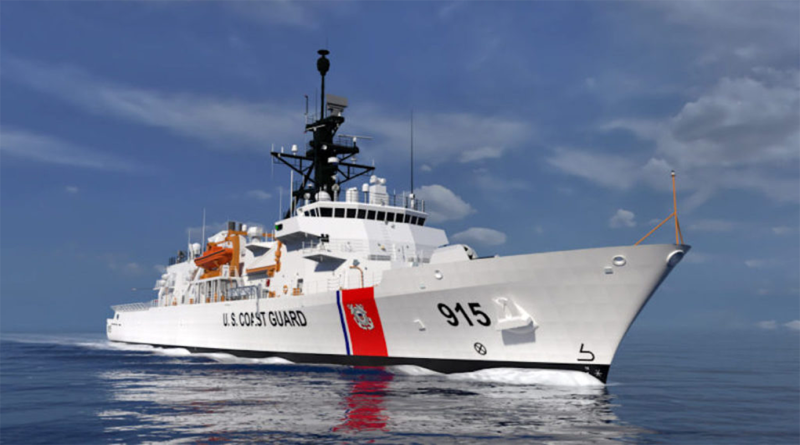Inside the New Heritage-Class Offshore Patrol Cutters
The Strategic Importance of the Heritage-Class Offshore Patrol Cutters
The Heritage-class Offshore Patrol Cutters (OPCs) represent a crucial advancement in modernizing the U.S. Coast Guard fleet, serving as a bridge between the larger National Security Cutters (NSCs) and the smaller Fast Response Cutters (FRCs). These new vessels are set to replace the ageing medium-endurance cutters (WMECs) that have served for decades.
Construction of the first Heritage-class cutter, USCGC Pickering, is underway, marking a key investment in U.S. maritime security. These vessels are designed to enhance the Coast Guard’s capacity to conduct a broad range of missions, including law enforcement, search and rescue, homeland security, and defence operations. The OPCs address existing gaps in operational capabilities, ensuring that the Coast Guard is prepared to handle emerging maritime threats.
Key Features and Capabilities of the Heritage-Class Cutters
Heritage-class OPCs are equipped with several advanced features tailored to meet the Coast Guard’s evolving operational needs. Each cutter is 360 feet long, with a displacement of about 4,320 tons, balancing speed, range, and endurance. They are powered by Fairbanks Morse marine diesel engines, providing a range of 10,200 nautical miles at a cruising speed of 14 knots, with a maximum speed of 22.5 knots. The cutters can remain at sea for up to 60 days, maintaining a persistent presence in both nearshore and offshore environments.
The ships are armed with a BAE Mk 110 57mm gun, a Mk 38 Mod 2 25mm autocannon, and multiple .50 calibre defence machine guns. They are also outfitted with advanced technological systems, including the Saab Sea Giraffe MMR radar and the AN/SLQ-32C(V)6 electronic warfare system, to enhance their surveillance and response capabilities. Additionally, the cutters incorporate clean energy features, such as an auxiliary propulsion motor for station-keeping and an integrated propeller-rudder system for improved hydrodynamic efficiency.
These features allow the OPCs to operate in a range of environments, from calm coastal waters to the challenging conditions of the Arctic. The design includes a large flight deck that can accommodate MH-60 or MH-65 helicopters and space for over-the-horizon small boats, further extending their operational reach and versatility.
Improving U.S. Coast Guard Missions with Versatile Operations
The Heritage-class OPCs support a diverse range of missions critical to U.S. Coast Guard objectives, including drug interdiction, illegal fishing prevention, and maritime law enforcement. They also play a crucial role in search and rescue operations, disaster response, and Arctic deployments, where robust and adaptable vessels are essential.
These cutters serve as mobile command and control platforms during surge operations, such as hurricane responses or mass migration incidents, enabling the Coast Guard to respond rapidly to diverse threats and emergencies. Their increased range and endurance allow them to maintain operations far from home ports for extended periods, which is crucial for missions in remote and high-risk areas like the Arctic. The vessels’ advanced communication and surveillance systems also enhance their ability to carry out nine of the Coast Guard’s 11 statutory missions effectively.
By integrating capabilities previously divided among multiple types of ships, the OPCs provide a more efficient and cost-effective solution to maritime challenges. This consolidation reduces maintenance burdens and increases fleet readiness and responsiveness.
Addressing Modern Challenges in Maritime Security
The Heritage-class cutters directly address the limitations of the older WMECs, many of which have been in service for over 40 years and are increasingly costly to maintain. In contrast, the OPCs are equipped with modern technology and designed to meet the demands of contemporary maritime security environments, from human trafficking and smuggling to environmental protection and fisheries enforcement.
These new cutters are also strategically important for addressing emerging geopolitical challenges. As the Arctic becomes more accessible, new shipping routes and opportunities for resource exploration are opening up. The Heritage-class cutters are designed to operate in these environments, providing a capability for the Coast Guard to project presence and enforce U.S. laws in Arctic waters. Their capacity to support aircraft and boat operations in higher sea states enhances their utility in rough conditions.
Moreover, the cutters improve the Coast Guard’s ability to collaborate with other federal and international agencies, facilitating joint operations and information sharing critical to countering transnational threats. This interoperability ensures that the Coast Guard remains an effective partner in global maritime security efforts while maintaining a robust defence posture domestically.
Future Implications and the Path Ahead for the U.S. Coast Guard
The introduction of the Heritage-class OPCs marks a significant step in enhancing the U.S. Coast Guard’s readiness for future maritime challenges. The first OPC, USCGC Pickering, is expected to enter service by 2023, with additional vessels to follow. This rollout aligns with broader modernization efforts, including a $2.38 billion contract for the first nine vessels, with options for more as needed.
These new cutters will significantly expand the Coast Guard’s presence in critical regions, such as the Arctic, where increased commercial activity and geopolitical competition necessitate a strong U.S. maritime presence. The OPCs’ capabilities for surveillance, interdiction, and search and rescue are essential in these contested areas.
As the Coast Guard builds its fleet of Heritage-class cutters, it is also investing in technologies and practices that enhance efficiency and sustainability. This includes energy-efficient propulsion systems, advanced surveillance and communication equipment, and modular designs that allow for future upgrades. These investments will ensure that the Coast Guard remains agile and responsive in a complex maritime environment.
Sources:
- USCG Historian’s Office
- Naval News
- Naval Technology
- DCMS USCG
- Photo: Eastern Shipbuilding Group
